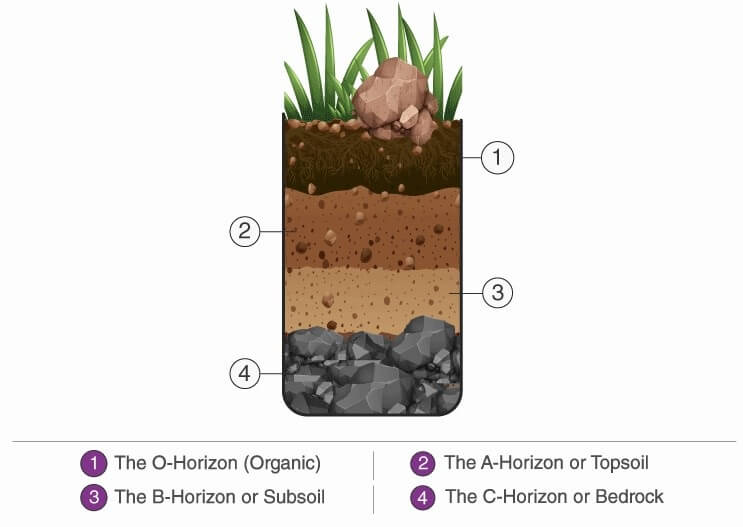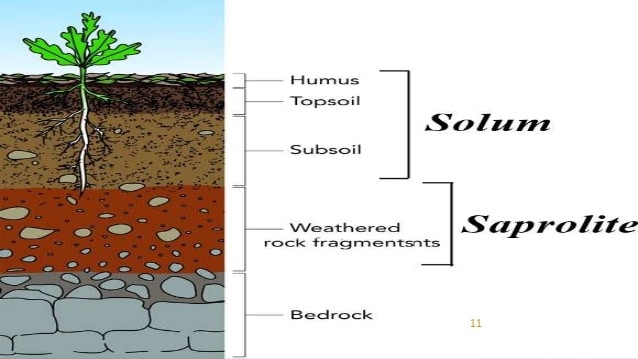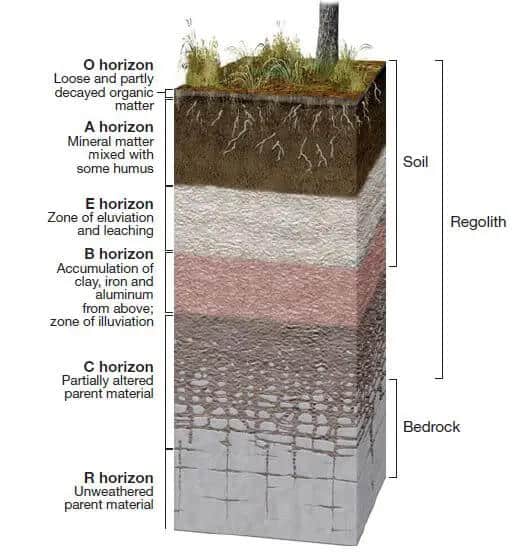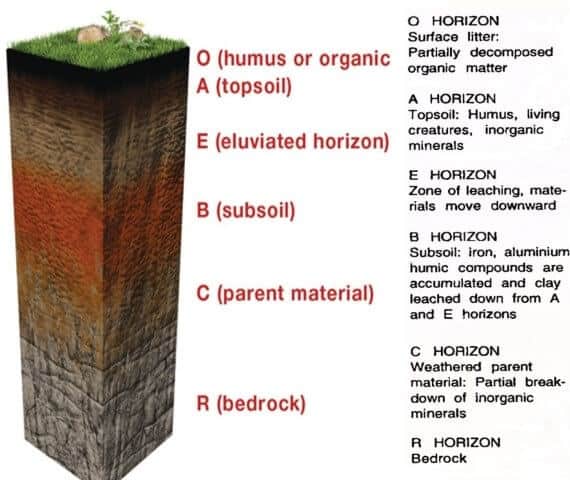The soil is the topmost layer of the earth’s crust mainly composed of organic minerals and rock particles that support life. A soil profile is a vertical cross-section of the soil, made of layers running parallel to the surface. These layers are known as soil horizons.
Soil Profile
A vertical section through different layers of the soil is called the soil profile. Soil consists of three horizontal layers. They are true soil at the top, sub soil, and bedrock.
Each layer differs in feel (texture), colour, depth, and chemical composition. Each layer of the soil is termed a horizon. Horizons are formed by internal processes like leaching or capillary movements/upward movements of materials & water.
Soil profile is studied through study of hexagonal column of soil taken as sample.

A soil horizon is a layer generally parallel to the soil surface, whose physical characteristics differ from the layers above and beneath.
Horizons are defined in most cases by obvious physical features, chiefly colour and texture.
The uppermost horizon is generally dark in colour as it is rich in humus and minerals. The humus makes the soil fertile and provides nutrients to growing plants. This layer is generally soft, porous, and can retain more water. It is called the topsoil or the A-horizon.
The next layer has a lesser amount of humus but more of minerals. This layer is generally harder and more compact and is called the B-horizon or the middle layer.
The third layer is the C-horizon, which is made up of small lumps of rocks with cracks.
Components of the Soil Profile
A soil horizon makes up a distinct layer of soil. The horizon runs roughly parallel to the soil surface and has different properties and characteristics than the adjacent layers above and below. The soil profile is a vertical section of the soil that depicts all of its horizons. The soil profile extends from the soil surface to the parent rock material.
The regolith includes all of the weathered material within the profile. The regolith has two components: the solum and the saprolite. The solum includes the upper horizons with the most weathered portion of the profile. The saprolite is the least weathered portion that lies directly above the solid, consolidated bedrock but beneath the regolith.

Soil Horizons
They develop through interactions among climate, living organisms, and the land surface, over time. Horizons usually develop either by selective removal or accumulation of certain ions, colloids, and chemical compounds. This removal or accumulation is normally produced by water seeping through the soil profile from the surface to deeper layers. Horizons often have different soil textures and colors.
There are two types of soil horizons: organic and mineral.
Organic horizons, marked with the capital letter O, lie over mineral horizons and are formed from plant and animal matter. The upper Oi horizon contains decomposing organic matter that you can easily recognize by eyes, such as leaves or twigs. The lower Oa horizon contains humus, which has broken down beyond recognition.
Mineral horizons: There are four main mineral horizons: A, E, B, C

O Horizon
- Layers dominated by organic material.
- Some O layers consist of undecomposed or partially decomposed litter (such as leaves, needles, twigs, moss, and lichens).
- They may be on top of either mineral or organic soils.
A Horizon or Surface soil
- It is the part of top soil.
- In this layer, organic matter is mixed with mineral matter.
- It is the layer of mineral soil with the most organic matter accumulation and soil life.
- Nutrients like iron, aluminium, clay, and organic matter are sometimes dissolved and carried out in this layer.
- This layer is depleted of (eluviated of) iron, clay, aluminum, organic compounds, and other soluble constituents.
- When depletion is pronounced, a lighter colored “E” subsurface soil horizon is apparent at the base of the “A” horizon.
E horizon
- “E” stands for eluviated layer.
- It is a light-colored eluviated layer, that is eroded of its nutrients.
- It is the horizon that has been significantly leached of clay, iron, and aluminum oxides, which leaves a concentration of resistant minerals, such as quartz, in the sand and silt sizes.
- These are present only in older, well-developed soils, and generally occur between the A and B horizons.
B Horizon or Subsoil
- It is a subsurface layer reflecting chemical or physical alteration of the parent material.
- This layer accumulates all the leached minerals from the A and E horizon.
- Thus iron, clay, aluminum, and organic compounds accumulate in this horizon [illuviation (opposite of eluviation)].
C Horizon or Parent rock
- Partially Weathered parent material accumulates in this layer, i.e. the parent material in sedimentary deposits.
- It is the least weathered horizon. Also known as the saprolite, it is unconsolidated, loose parent material.
- This layer may accumulate more soluble compounds (inorganic material).
R Horizon or Bedrock
- This layer denotes the layer of unweathered bedrock at the base of the soil profile.
- Unlike the above layers, R horizons largely comprise continuous masses of hard rock.
- Soils formed in situ will exhibit strong similarities to this bedrock layer.
- These areas of bedrock are under 50 feet of the other profiles.

Significance
- The study of the soil profile is significant in agriculture sciences because the land use pattern can be determined.
- Land capability classification is based on the study of soil profile & horizon.

thank you
Fabulous